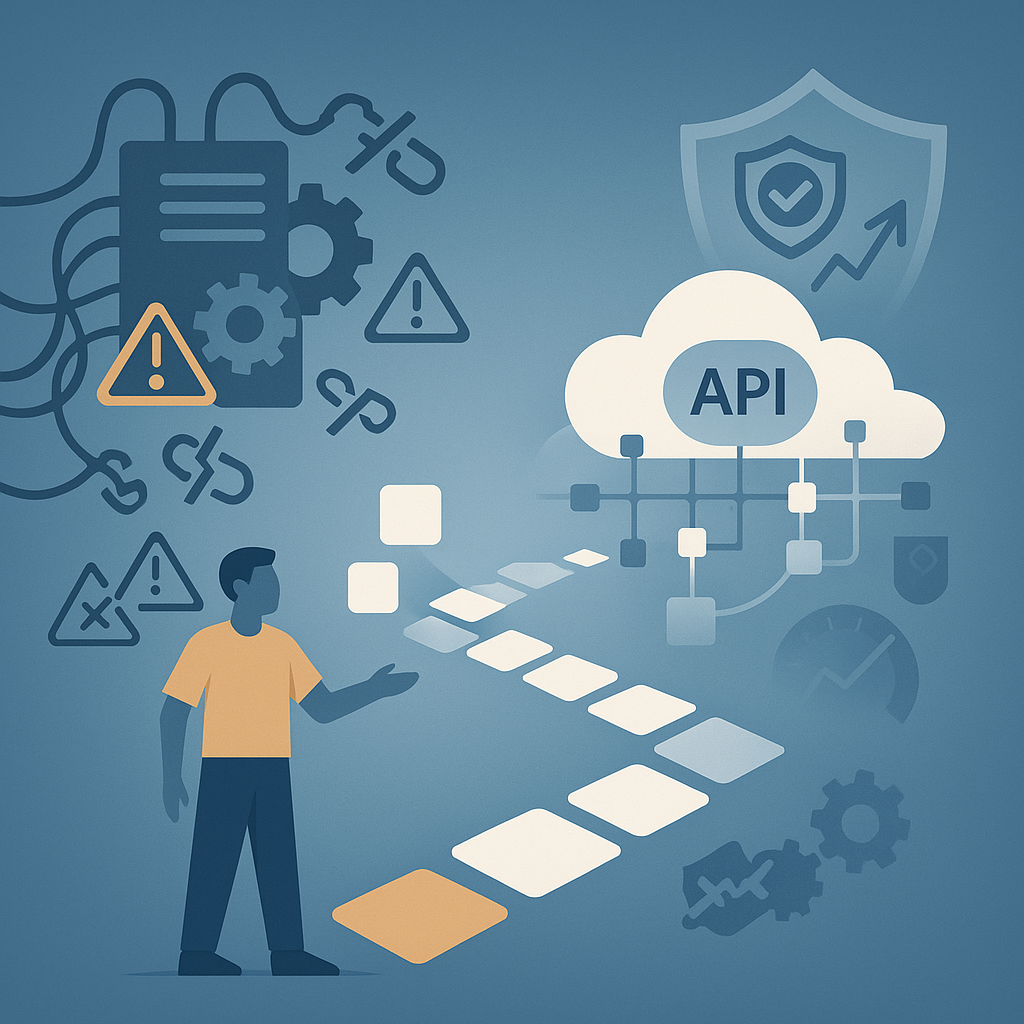In today’s P&C market, “legacy” doesn’t just mean outdated, it means expensive. For many carriers, core claims platforms that were cutting-edge ten years ago now function less like an asset and more like an anchor. The real drag isn’t just the visible operational inefficiency; it’s the technical and strategic (and even cultural) integration debt these systems accumulate, locking carriers into patterns that widen competitive gaps year after year.
The Hidden Weight of Integration Debt
Integration debt is the compound interest of years spent bolting on point solutions, middleware, and workarounds to aging core systems. Every claims leader knows the feeling: you add a new vendor tool to improve one part of the process, only to discover that integrating it with the core platform takes twice as long as expected and requires custom scripts, brittle APIs, and manual data reconciliation.
The immediate costs are obvious and include IT spend, delays, and frustrated teams. But the deeper costs are often invisible:
- Innovation Lag: While competitors launch AI-assisted FNOL workflows or real-time fraud scoring, carriers mired in integration debt are still working through RFPs to see if their core can even connect to these tools without major surgery.
- Market Response Slowdown: CAT events don’t care about platform constraints. Legacy systems that can’t flex to new triage models or rapidly scale vendor resources leave carriers scrambling to catch up instead of leading from the front.
- Opportunity Cost in Data: Fragmented integrations limit the ability to operationalize claims data for predictive modeling, leakage detection, and customer experience improvements. Carriers end up with partial insights when the market demands full visibility.
How Legacy Platforms Widen Competitive Gaps
Every year that carriers delay modernization, the distance between “digital-first” competitors and those on legacy platforms increases, not linearly, but exponentially.
- Speed-to-Market Advantage
New entrants and digitally-native MGAs can deploy capabilities in weeks. For legacy carriers, even small enhancements can take several quarters. This lag creates a perception—both internally and in the market—that the carrier is “behind,” which often becomes self-reinforcing. - Customer Experience Deficit
Policyholders accustomed to a new world of instant gratification increasingly expect Amazon-grade service: transparency, speed, and personalization. Legacy constraints limit self-service, proactive communication, and seamless omnichannel engagement. The result? Increased call volumes, longer cycle times, and NPS erosion. - Escalating Operating Costs
A fragmented claims ecosystem drives higher total cost of ownership. Carrier IT resources spend more time maintaining old integrations than building new value. In some cases, the sum of maintenance costs alone could instead fund significant modernization initiatives. - Talent Retention Risk
The best adjusters and claims leaders want to work with tools that help them succeed. When tech friction makes their jobs harder, frustration builds. Over time, this impacts not just morale, but retention of your most experienced and valuable staff.
The Overlooked Strategic Costs
While operational inefficiencies are measurable, the strategic costs are more insidious:
- Missed Partnerships – Some insurtech partners simply won’t integrate with outdated platforms, cutting carriers off from emerging capabilities in fraud, damage estimation, or customer engagement.
- Cultural Inertia – Overreliance on legacy systems can cement process rigidity, making it harder for teams to embrace new workflows or technology-driven decisioning.
- Regulatory and Security Exposure – Outdated tech stacks can’t keep pace with evolving compliance requirements or cybersecurity threats without expensive patchwork fixes.
Transitioning Without Disruption
The perceived barrier to modernization is often disruption risk: “We can’t afford downtime in claims.” The truth? You can’t afford not to modernize. The key is adopting a phased, parallel-path transition strategy that minimizes operational risk while delivering incremental value.
- Assess and Segment
Map your claims portfolio by complexity, frequency, and margin impact. Identify high-volume, lower-complexity claim types (e.g., small auto PD, low-severity property) as candidates for early migration to a modern platform. - Layered Modernization
Instead of a “big bang” cutover, deploy new capabilities as modular layers—such as cloud-based FNOL intake, AI-assisted document handling, automated payment rails—that integrate via APIs. This delivers early wins while building a future-ready architecture. - Parallel Operating Environments
For a defined period, run legacy and modern systems in parallel for different claim segments. This provides a controlled environment to refine workflows, validate integrations, and de-risk the eventual full migration. - Vendor and Partner Strategy
Choose partners who bring both domain expertise and proven migration playbooks. The right partner isn’t just a software provider, they’re a strategic ally in navigating regulatory requirements, data migration, and change management.
Enabling a Future-Ready Architecture
The endpoint of modernization isn’t just a “new system," rather, it’s an ecosystem that enables agility:
- API-First Design – A modern claims core should make integration easy, not an exercise in workarounds. This creates the ability to plug in new capabilities—like AI, IoT data streams, advanced analytics—without long development cycles.
- Cloud-Native Infrastructure – Cloud architectures allow dynamic scaling during CAT events, robust disaster recovery, and faster deployment of new features.
- Unified Data Layer – Consolidated data access across claims, underwriting, and customer engagement unlocks enterprise-level insights and predictive models that were impossible with siloed legacy systems.
The Strategic Partner Advantage
Modernizing claims is not just a technology project, it’s a transformation of how you compete. That’s where our role comes in.
As a committed solutions and technology partner, RENFROE® collaborates with carriers to overcome integration debt and safeguard business continuity. Leveraging deep P&C expertise and a consultative approach, we deliver tailored, modular solutions engineered for measurable results at every phase of the claims journey. From portfolio mapping to orchestrating seamless transitions, our flexible methodologies support sustainable transformation aligned with your growth strategy. The outcome: a faster, more precise, and cost-efficient claims process, empowering carriers to lead with confidence in a market defined by speed, insight, and trusted policyholder relationships.


